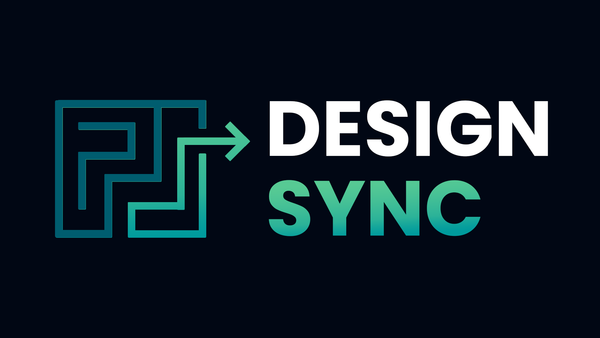Clair Obscur: Expedition 33 - Redrawing the Rules of RPG Combat
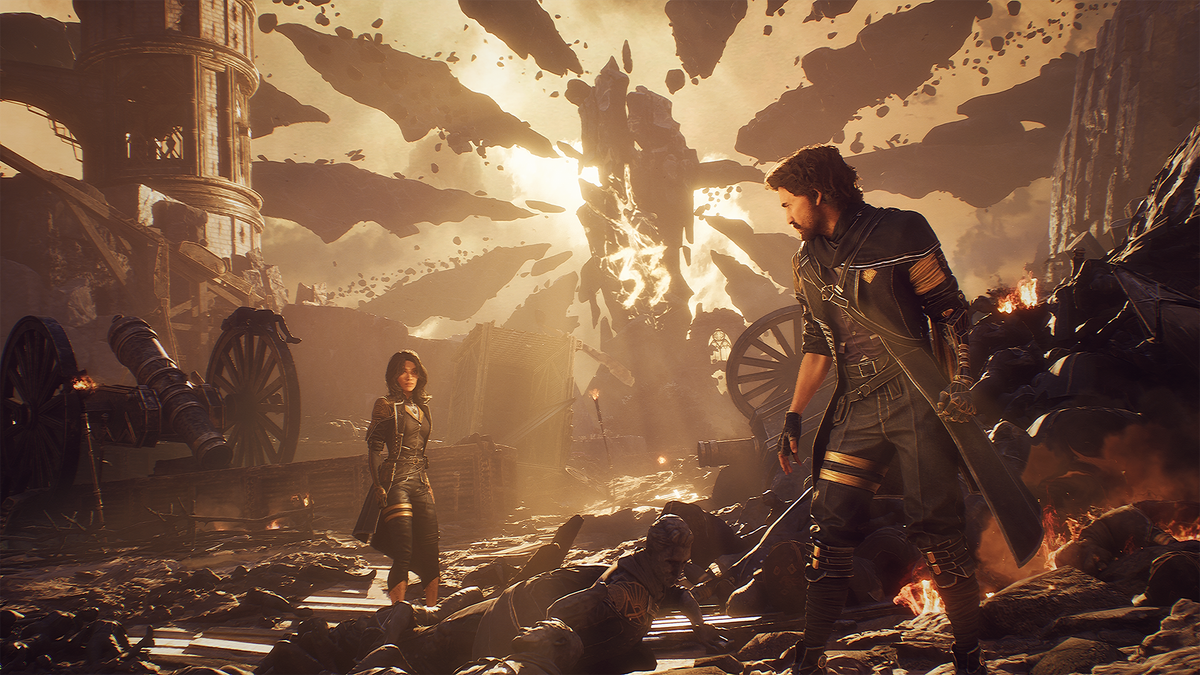
I've put together a handy Glossary to help you follow along.
Clair Obscur: Expedition 33 isn’t just a painterly RPG; it’s a bold experiment in hybrid combat. By fusing turn-based tactics with real-time execution, it doesn’t just bend genre rules—It dares to redraw them.
What it creates is ambitious, clever, and occasionally brilliant. But despite being interesting in it's own right, the real story is in the tradeoffs, the choices it makes, and the doors it leaves open.
In this article, we’ll break down where it hits, where it stumbles, and what it teaches us about syncing strategy with skill.
What is it?
Clair Obscur: Expedition 33 is the debut title from Sandfall Interactive, a French studio making a confident first impression.
Released in April 2025, Clair Obscur is a turn-based RPG with real-time elements set in a Belle Époque-inspired world unraveling under a surreal, ritualistic curse. The game opens in the decaying city of Lumière, a place haunted by memory and ritual, where each year, a supernatural rite called The Gommage erases everyone of a certain age. This year, it’s 33—so a desperate expedition sets out to end the cycle once and for all.
You play as Gustave, a pragmatic engineer with one year left to live. Alongside a cast of distinct, purpose-driven companions, you venture into the unknown to uncover the source of the curse and confront the system behind it.
Why is it Important?
Clair Obscur wasn’t just a debut—it was a breakout success. It has received glowing critical reception, catching attention for its fresh take on RPG combat.
The game sold over one million copies in its first three days and tripled that by the end of its first month, despite being available on Xbox Game Pass. Critics praised its bold design, bespoke aesthetic, and narrative ambition. Its soundtrack broke onto classical charts. A film adaptation is already in development.
For a first release, this is more than impressive—it’s defining.
What Makes It Different?
Clair Obscur: Expedition 33's hybrid system merges classic turn-based structure (think Final Fantasy or Baldur’s Gate) with fast real-time inputs (or, quick time events: QTEs). Whether you're into strategic turn-based play or twitchy real-time action, this game pulls off something rare: it blends both, and does so seamlessly.
While the Sandfall team clearly draws inspiration from Final Fantasy X and Lost Odyssey, they arguably capture the spirit of those games more convincingly than Square Enix has in recent years.
Combat revolves around building meter through melee attacks, spending it on ranged abilities, and surviving with precise reactive verbs like dodges or parries in real time. The result is clean, fluid, and expressive gameplay that favors rhythm and momentum over strict turn economies.
But what does that really mean for how the game feels? And why should designers care? Let’s break down how and why that works.
The Basics: A Hybrid System That Keeps You Moving
Hybrid systems are tricky to balance. Lean too far into action, and players burn out. Pull back too much, and the system risks becoming slow or boring.
Clair Obscur handles this with smart pacing tools—stagger mechanics, character-specific rhythms, and consistent combat variance that keep each encounter fresh and exciting. The result is a strong case study in blending genres without losing clarity.
Most turn-based games ask you to act, then wait while enemies do the same. Although this creates some nice space to breathe, this often results in combat scenarios feeling more passive than tactical. Clair Obscur changes that by keeping players actively involved on every turn, at every moment.
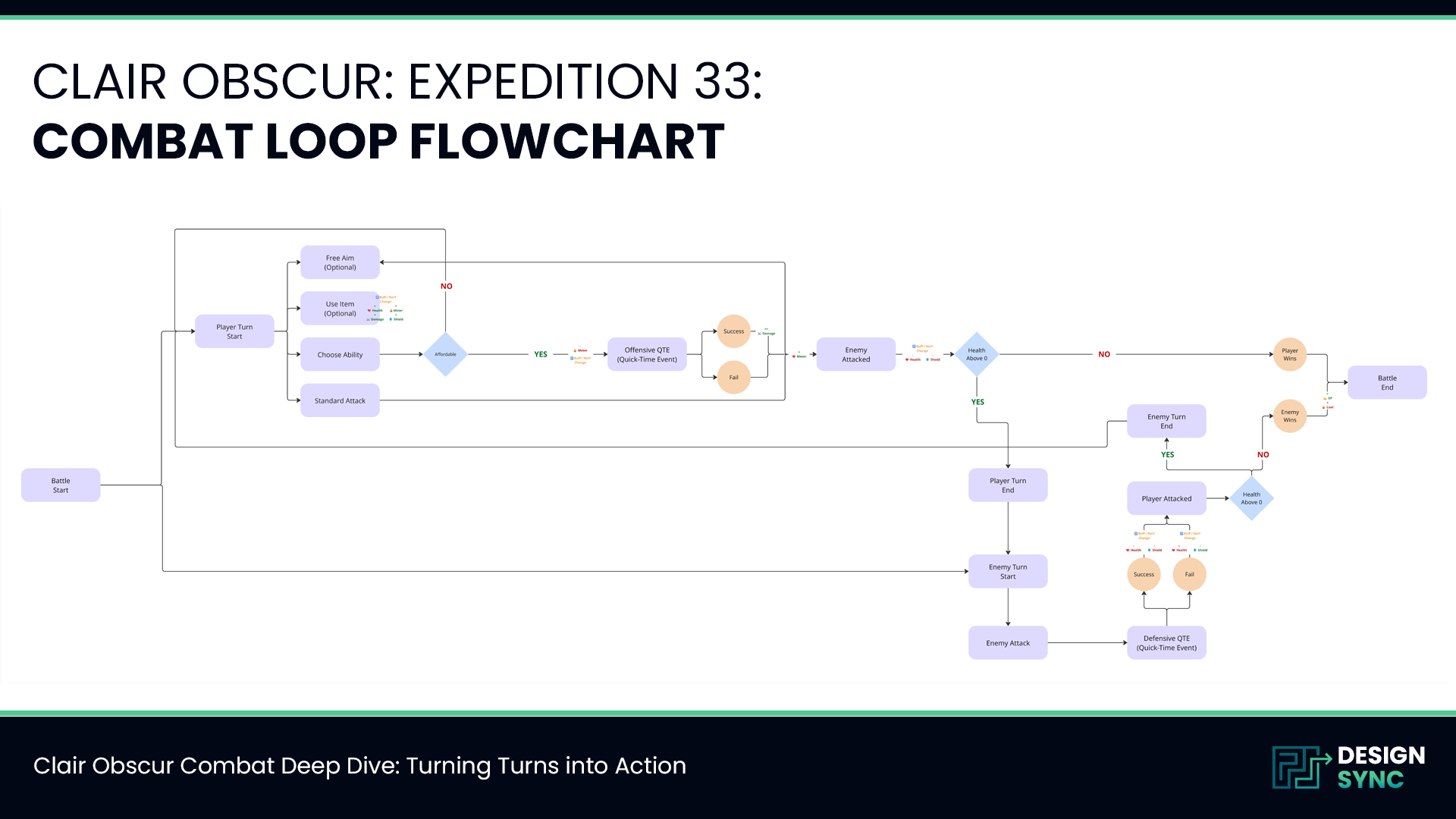
During each player turn, you can:
- Use regular attacks.
- Spend AP (Action Points) on skills.
- Use Free Aim shots to target weak points.
- Deploy items like Healing Tints.*
During enemy turns, you’re not just watching—you’re dodging, parrying, and timing jumps in real time. When it’s your turn, success means more than picking the right move—it’s about landing hits through perfectly timed quick-time events.
This turns combat into a rhythm. Strategy and skill trading off like steps in a dance.
What You’ll Find in the Deep Dive
In the full article, we’ll dig into:
- How the combat system manages player attention, rhythm, and tempo.
- The strengths and weaknesses of enemy design.
- How characters’ unique abilities shape the player experience.
- What all this reveals about aligning design intent with production reality.
Clair Obscur has bold ideas. In this deep dive, we’ll explore not just what Clair Obscur does, but why it works and what it teaches us about building better combat systems.
Design Goals at a Glance
The combat system appears built around three core goals:
- Keep the player engaged during every moment of the encounter.
- Merge tactical depth with reactive skill.
- Reinforce character identity through mechanical expression.
This is combat design with a purpose—and that purpose is felt in every input. But when every input demands focus, pacing becomes critical. Without moments of release, the same strength can become a source of fatigue.
Hybrid Combat: Designing for Constant Engagement
At its core, Clair Obscur runs on a turn-based skeleton. But instead of letting players settle into predictable rhythms, it pulls them back into the moment with:
- Real-time dodges, jumps, and parries during enemy turns.
- Quick-time events (QTEs) that enhance attacks through timing.
This design solves a common friction in traditional RPGs: passive downtime. By demanding input during defense and rewarding precision during attacks, Clair Obscur transforms passive watching into active play.
However, when every moment matters and requires attention and physical timing, long encounters risk becoming mentally exhausting (see: Cognitive Load). That’s the tradeoff: designers gain immersion, but lose opportunities for rest.
Combat depth increases when defensive actions aren't just about reaction, but about judgement. The addition of situational verbs, like reflect, evade, and guard, could add to skill differentiation, while broadening the skill ceiling and offering brief windows of relief and variety.
Currently, Clair Obscur emphasizes mastery and flow—but that can come at the cost of approachability and fatigue.
Tempo, Rhythm, and Time-to-Resolution
Many hybrid systems suffer from combat bloat—encounters that drag due to flashy mechanics without mechanical payoff. Clair Obscur’s Break system helps mitigate this by creating rhythm:
- Micro-goals encourage proactive planning.
- Stagger phases condense damage windows.
- Pressure cycles create tension and release.
Together, these tools form a rhythmic loop that keeps battles moving. This cadence gives each battle a distinct pulse, keeping players engaged moment to moment. But rhythm alone doesn’t guarantee momentum.
The impact on time-to-resolution (TTR) depends on how well break thresholds scale—and whether QTEs and real-time defense speed up or slow down the flow. If animations run long or enemy HP pools are too generous, even a reactive system can start to feel sluggish.

The Break system delivers satisfying tempo shifts and trims downtime—but it’s not without tradeoffs. Repetitive QTEs and reactive defense sequences can stretch out later encounters. What builds tension early may eventually wear thin.
To sustain engagement, pair reactive systems with efficient resolution. In other words, keep encounters and combat inputs meaningful. Deliver momentum without over-extending each encounter.
So far, we’ve looked at how Clair Obscur keeps players engaged moment-to-moment. But what happens across the arc of a full encounter—or over dozens of hours?
Action Layer Breakdown
Combat in Clair Obscur works because it operates on multiple layers at once. Some moments ask you to plan, others demand precision, and some are pure reaction. The game keeps shifting where your attention goes, and that’s where its hybrid feel really kicks in.
To make that structure clearer, here’s a breakdown of the main input layers players cycle through in each encounter:
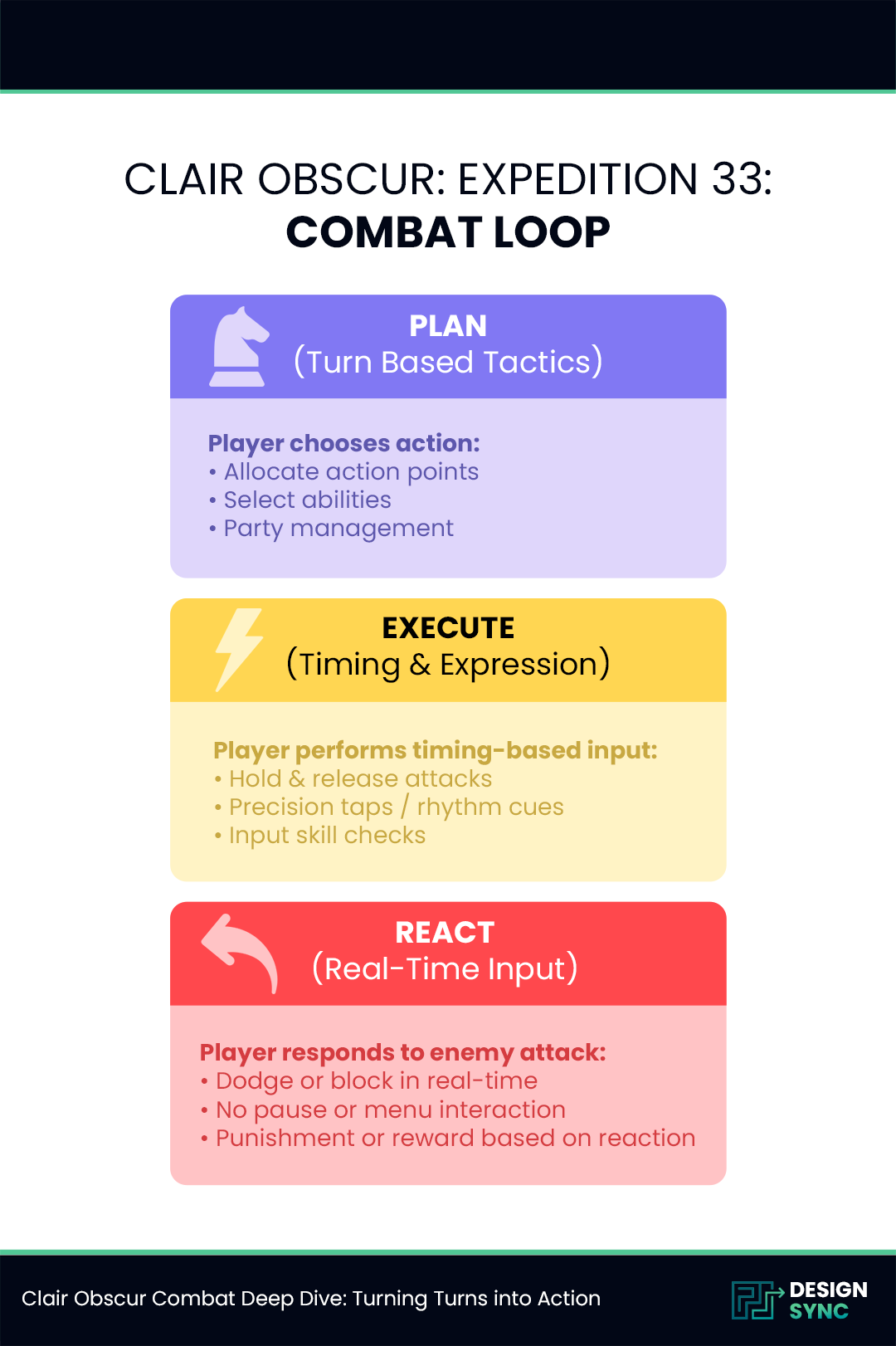
Some characters lean more into one layer than another. Verso, for example, thrives in Execute. Sciel lives in Plan. Maëlle shifts between all three depending on her stance. That diversity is part of what keeps the system expressive—but it also means the game has to stay on top of pacing and encounter shape, otherwise, all those overlapping inputs risk turning to noise.
Next, let’s look at how well it holds up under pressure—specifically in enemy design.
Encounter Composition & Enemy Design
While player mechanics are robust, most enemies feel similar in how they engage the player. They may differ in animation or size, but not in role or strategy. Combat devolves into pattern recognition rather than adaptation.
Effective encounter design should:
- Feature distinct combat roles (e.g., tank, disruptor, finisher).
- Challenge different player habits (e.g., anti-mashing, area denial).
- Coordinate synergies (e.g., buff / debuff chains or stagger punishers).
Currently, most encounters lean on pattern memorization rather than strategic adaptation. That makes fights exciting at first—but risks hurting replayability and long-term engagement.
A deeper combat loop benefits from encounter archetypes that disrupt expectations through synergistic enemy roles, reactive ability chains, or counterplay-driven mechanics. When all enemies function similarly, encounters can lose shape. What’s gained in spectacle may be lost in strategic tension and role clarity.
Games like Monster Hunter excel here.

Even solo, monsters perform unique behavioral patterns. Some pin you down with aggression, while others control space and force defensive repositioning. In multiplayer, that variety becomes dynamic: monsters interact with the environment and each other, creating unpredictable combat puzzles that reward improvisation, awareness, and preparation. You’re not just learning patterns—you’re adapting to evolving threats.
Clair Obscur could gain a lot from borrowing that encounter logic. The richest battles come from enemies that work together—forcing players to respond to synergy, not just survive the script.
Action Economy & Resource Loops

Clair Obscur makes a bold choice by prioritizing feel over math. There’s no obvious turn delay, no visible cooldowns, and few friction points between input and impact. The result is fluid, stylish combat—but that smoothness comes at a cost.
Without constraints like cooldowns, limited use resources, or recovery windows, players quickly fall into predictable play patterns. When every ability is always available, the tension fades. Without constraints, players find optimal loops fast. And once found, they rarely break them.
Strong combat systems rely on managing pacing and resource tradeoffs. Examples include:
- Cooldown interactions and turn delays
- Resource build-and-spend loops
- Balancing aggression with recovery
Persona 5 is a great example.

Combat moves fast and feels exciting, but it’s rooted in tight resource management. You’re constantly weighing long-term risks against short-term wins. SP* is limited, and burning through your best skills early can leave you vulnerable later.
The “One More” system rewards smart targeting, but also forces players to think carefully about party roles and elemental weaknesses. You're constantly weighing whether to press forward or hold back—and that tension sustains the experience far beyond the opening hours.
Clair Obscur doesn’t yet enforce clear tradeoffs between spamming power and building toward it. That keeps the moment-to-moment engaging but risks flattening long-term engagement. Introducing mechanics like interleaved turns, cooldown windows, or reactive status effects could add meaningful layers to decision-making, pushing players from simple reflex toward deeper strategic adaptation.
It’s not about slowing the game down—It’s about giving players more to think about. That kind of deliberate tension would perfectly complement Clair Obscur’s haunting themes—where every choice matters, and the line between control and chaos is razor-thin.
Character Kits: Mechanics as Identity

Where Clair Obscur truly shines is in its character-specific mechanics. Each party member reshapes the combat system around them, for example:
- Lune builds up and then expends elemental energy called Stains to cast powerful spells. Each Stain corresponds to a specific element, like fire, ice, or lightning.
- Sciel stacks predictive effects using a system called Foretell, then detonates them for damage.
- Verso thrives on precision. She gains power by maintaining Perfection—a streak system that rewards consistent timing and input. Think of it like a combo meter that resets if you make a mistake.
- Monoco shapeshifts into enemies using a spinning, bestial wheel—an unpredictable transformation mechanic that grows stronger the longer it spins.
These aren’t just flavor—they reshape core mechanics. They're lens shifts. And they serve narrative identity.
From a design standpoint, each character:
- Offers a distinct rhythm of play.
- Reinforces their narrative identity.
- Encourages build experimentation and team synergy.
However, the strength of that fantasy-mechanic connection varies. Some kits feel tightly interwoven with the character’s emotional arc, while others feel more bolted on.
Sciel’s predictive stacking, for instance, mirrors her role as a seer and reinforces her forward-looking mindset—it’s elegant and thematic. In contrast, Monoco’s shapeshifting and spinning wheel feel more abstract—mechanically novel, but less grounded in a clear emotional or narrative thread. When that alignment clicks, the experience becomes personal. When it doesn’t, kits risk feeling stylish but hollow.
Emotional resonance in combat emerges when mechanics express character motivation. This kind of integration only happens through close cross-discipline collaboration—and it’s what transforms gameplay into storytelling. When it works, players feel who they are in how they play.
Status, Control, and Strategic Play
Beneath the QTE flash lies a solid foundation layer of classic RPG design supporting it:
- Status effects (poison, burn, freeze).
- Buffs, debuffs, and control effects.
- Enemy weaknesses and status applications.
- Tactical flexibility through character modes and stances.
These systems aren’t flashy—they’re foundational. They quietly do the essential job of shaping how players engage with each fight.
Maëlle’s stances, for example, offer a strategic axis beyond reaction time. Switching between them adjusts her available abilities and lets players shift tempo mid-fight—trading offense, defense, and utility to match encounter flow.
Similarly, Lune’s spells lean heavily on status application and debuffs, giving players tools to poison, weaken, or manipulate enemies over time. These mechanics aren’t just add-ons—they’re how each character expresses identity through play.
By contrast, games like Final Fantasy XVI—though visually similar—lean far more into real-time spectacle.

While they offer powerful abilities, status effects and encounter control take a backseat to cooldown rotations and cinematic flair. The result is a combat system that’s immediately gratifying, but often lacks the layered, long-form tension that RPG veterans look for.
A combat system’s staying power often hinges on its status toolkit—bleeds, disables, threat control. Without them, hybrid systems risk skewing too twitchy, sacrificing long-term strategic depth. Clair Obscur sidesteps that risk by embedding traditional RPG control mechanics inside a visually modern, reflex-driven shell.
It’s a layered design: flashy up top, thoughtful underneath.
Production Sync: Implementation Matters
Each system implies a production cost. Consider the implications:
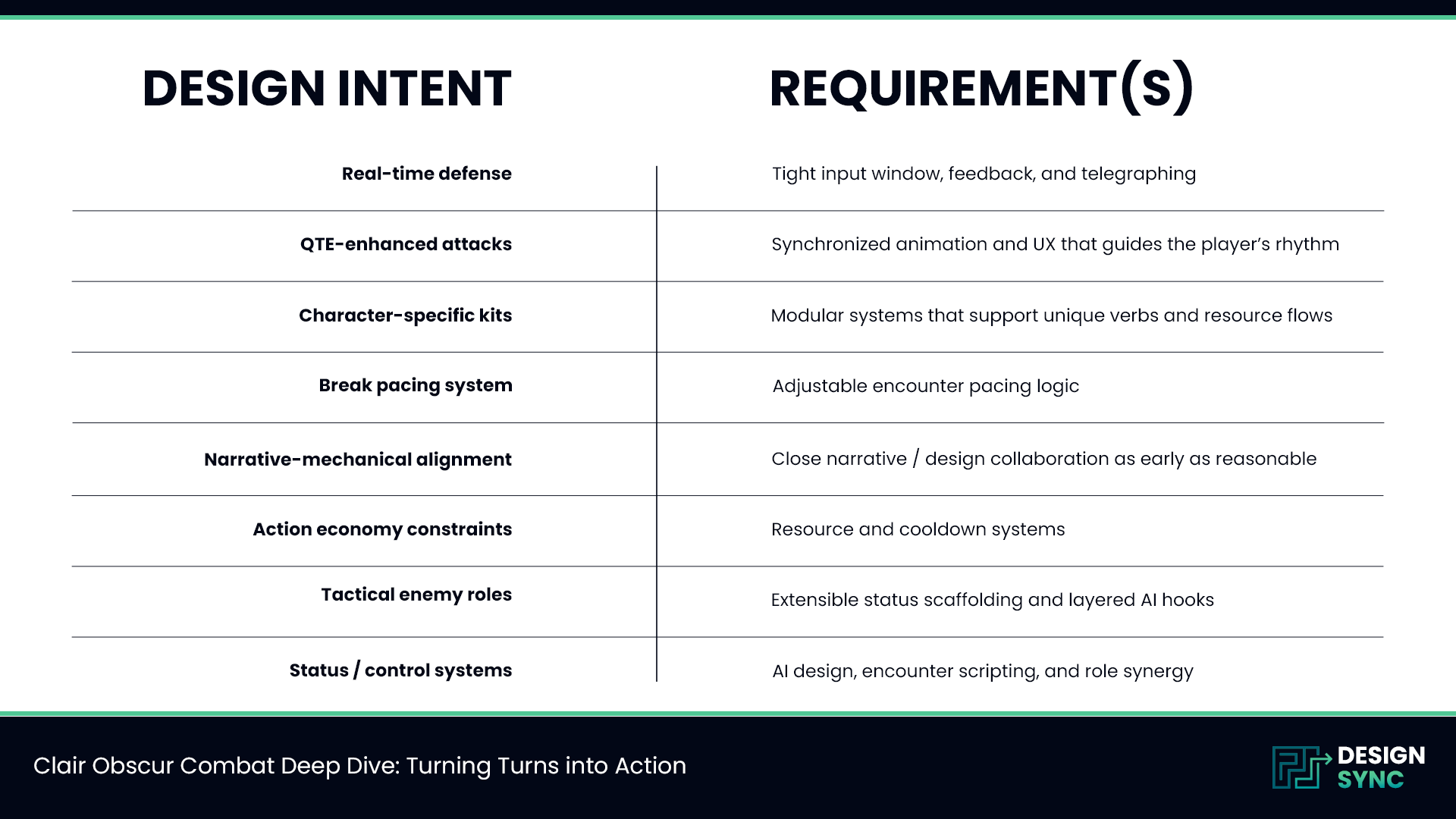
Every system you add comes with an implementation cost—and every shortcut you take shapes how deep (or flat) the player’s experience feels.
Final Takeaway: Combat as a Full-Body System
Clair Obscur’s combat works because it doesn’t treat turns and timing as opposing forces; it sees them as complementary muscles. It’s a full-body combat system: brain (strategy), hands (reflex), and heart (feeling).
That said, we can strengthen that hybrid combat system foundation further by:
- Varying tempo without stretching encounters.
- Deepening encounters through enemy role interplay.
- Balancing reflex demands with resource decisions.
- Aligning player fantasy with mechanical verbs.
- Layering in status, control, and defensive choice variety.
Every decision is a tradeoff. Spectacle costs strategy. Responsiveness costs rest. Fluidity costs friction.
Combat that sticks doesn’t avoid these tensions; it navigates them with intent. By fusing planning, timing, and reaction, Clair Obscur doesn’t just remix genres; it reimagines what turn-based combat can feel like. It’s a vision that captures both the promise and the price of hybrid design, and it leaves behind one hell of a blueprint.
Thanks for reading! ✌️
If you found this breakdown useful, subscribe to Design Sync for more game design deep dives.


